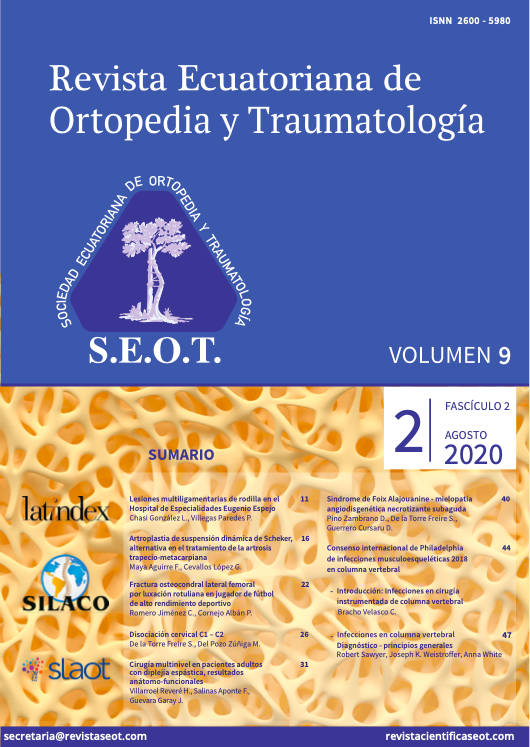Lesiones multiligamentarias de rodilla en el Hospital de Especialidades Eugenio Espejo
Main Article Content
Abstract
The objective of this study is describe the characteristics of patients treated for multiligamentary knee injuries in the Traumatology and Orthopedics Service of the Eugenio Espejo Specialties Hospital from January 2012 to June 2019.
Materials and Methods: Through the collection of data from surgical reports, all patients with diagnosis and treatment of multiligament injuries were included and a descriptive statistical analysis was performed using the SPSS statistical package. Results: 35 knees (34 patients) were included in the study. The prevalence of Multiligament Injuries is 2.71%. The average age was 30-31 years, most often in the male gender (82.86%). 94.29% of patients underwent multiligament reconstruction. The average evolution time was 15-17 months. The most frequently injured ligament was the ACL in the 85.71%. According to the Schenck Classification 45.71% was KD I grade, 20.00% KD II grade, 14.29% KD IIIM grade, and 20.00% was KD IIIL grade. 94.29% were surgically managed by multiligament reconstruction. 96.97% of the surgeries were performed in a single surgical time, including a patient with bilateral multiligament injury. The most commonly used surgical techniques were TransTibial technique in 53.33% (LCA), Anterolateral monoband technique in 91.67% (LCP), anatomical reconstruction technique in 55.56% and 63.16% for Posteromedial Corner (PMC) and Posterolateral Corner injuries (PLC), respectively. 51.52% of the cases used autograft. The most frequently associated lesions were the meniscals (57.14%). Complications occurred in 14.28% (5 cases).
Conclusions: Most of multiligamentary lesions occur in men in the second decade of life, most often the lesion of ACL associated with EPL, with a tendency to surgical management with anatomical reconstruction techniques.
Article Details

This work is licensed under a Creative Commons Attribution-NonCommercial-NoDerivatives 4.0 International License.

